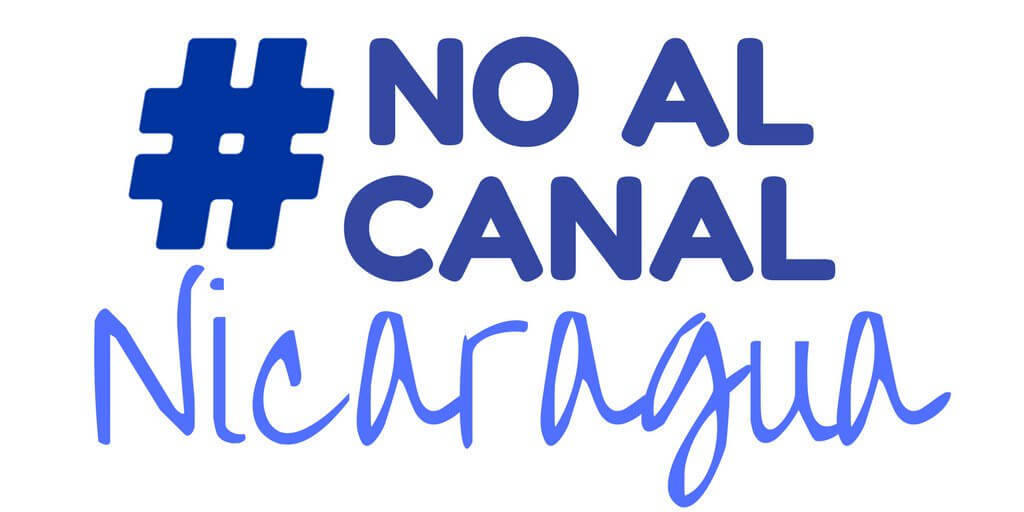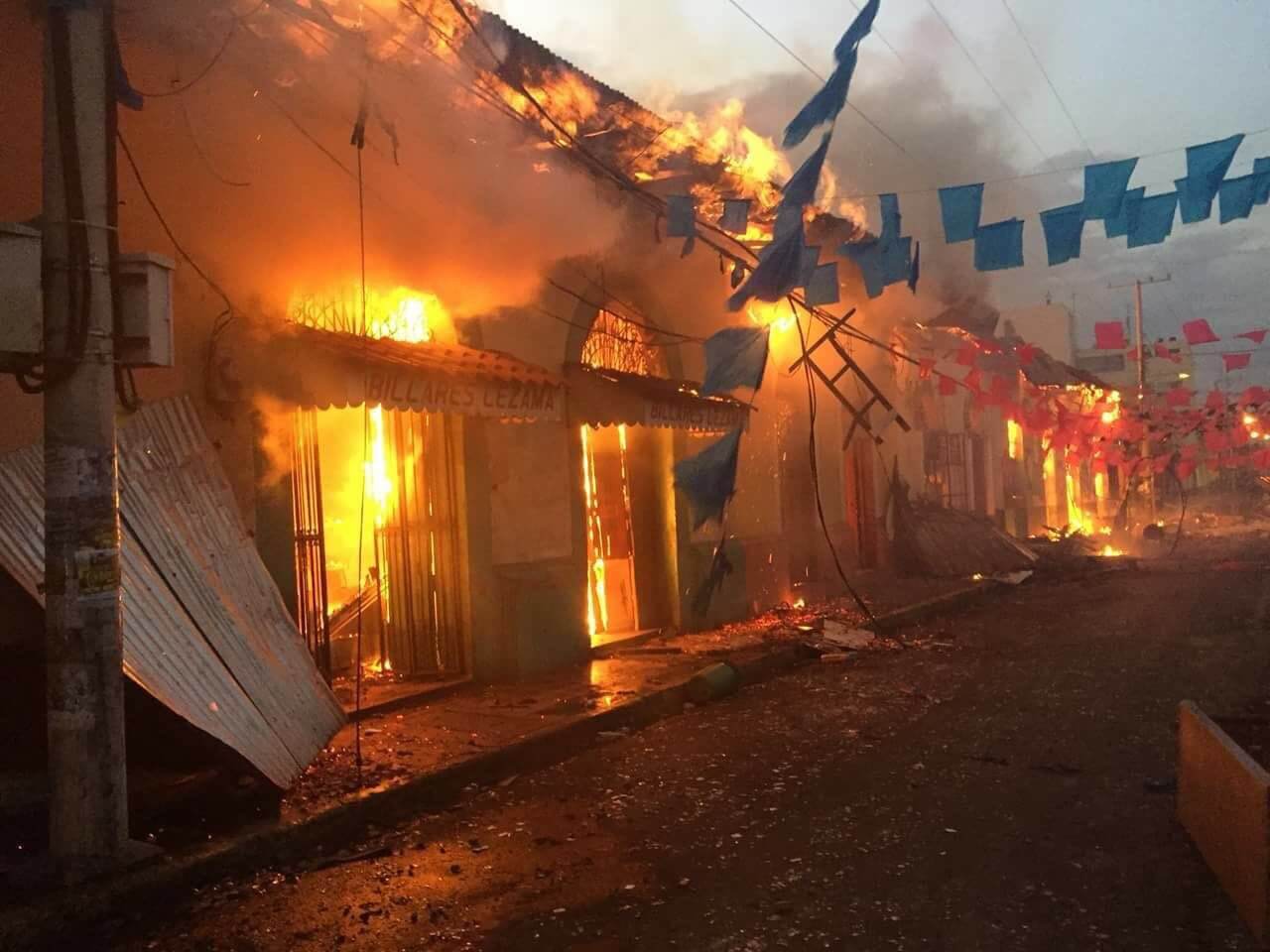
by Deep Green Resistance News Service | Apr 28, 2018 | Protests & Symbolic Acts
Featured image: Destruction in León. Source anonymous. The official death toll from explosions of state violence has risen to 63.
by Laura Blume / Intercontinental Cry
Over the past week, Nicaragua has erupted in protests. While this current crisis started over pension reform, its development has revealed far greater rifts. It appears Nicaraguans have finally had enough of the Ortega regime. They are demanding that the corruption and oppression end. For many, it may seem shocking that a country that re-elected President Daniel Ortega for his third consecutive term in November 2016, with a reported 72 percent of the national vote could now, less than two years later, have taken to the streets en masse demanding his immediate removal from office.
I first visited Nicaragua in 2012, and have spent extensive time in the country over the past two years undertaking ethnographic fieldwork as part of my PhD dissertation. Each time I arrived in Nicaragua, I heard more and more people express mounting levels of frustration with the political situation. Yet, it was a frustration that the majority internalized and kept mainly to themselves, mentioning it to me only in private spaces and usually when other Nicaraguans were not around. As someone explained to me on one of my first trips to the country, “On the street, we’re all Sandinistas. We have to be if we want to work and have our kids go to school. But in private… well, there you may hear another story.”
I began hearing people who had fought in the 1978-79 Sandinista Revolution and 1981-90 Contra War lament that the current government now resembled the Somoza dynasty they had fought so hard and sacrificed so much to overthrow. Many people told me they were still a Sandinista, just not a Danielista, highlighting their commitment to the ideals of the historic fight against dictatorship and the Sandinista Revolution, but fundamental disagreement with the current regime.
Hearing about corruption and repression is one thing, but witnessing it is another. In November 2017, in Bilwi, the capital city of the North Caribbean Coast Autonomous Region of Nicaragua, I watched the Ortega Administration steal a local election. As I felt the burn of tear gas deployed against peaceful protestors and watched National Police – trucked in from the capitol – fire live rounds at the crowds, perspective on Nicaraguan politics changed, permanently.
In the 2017 municipal elections in Bilwi, the primary match-up was between two parties: the FSLN (Frente Sandinista de Liberacion Nacional, Sandinista National Liberation Front) and the indigenous Miskitu party YATAMA (Yatama Aslatakanka Masrika Nani/Sons of the Mother Earth). I decided I would try and divide my time between the contacts I had from each party, hoping to remain impartial. On election day, I spent the morning with a contact who supported the FSLN. I accompanied them as they drove FSLN voters to the polls. At one point, they admitted to me that certain claims of the opposition were valid: Nicaragua was a dictatorship. But they countered that not all dictatorships were bad, exclaiming, “just look at all the progress in Cuba!”
Around 4 pm that afternoon, I arrived at a voting center with a YATAMA contact. Although the official closing time for the center was 6pm, elections officials were shutting its doors. People became angry that they were not being allowed to vote. The situation grew tense as a crowd formed. People reported facing harassment from authorities – including two women who told me about threats of sexual violence – when they tried to demand their right to vote. I remember thinking how my FSLN contacts had stressed to me that they would be voting early in the day, and making sure other FSLN supporters did the same. Did they know this would occur in the afternoon? Reports of similar problems soon emerged from other voting centers around Bilwi.
A few hours later, waiting outside the same voting center in a crowd of YATAMA supporters as they observed a contested re-count of votes, I noticed a new group of people arriving – all young and male. They began encircling the YATAMA supporters and jeering at them. One of the young men tossed a handful of dirt towards them, clearly trying to instigate a fight. Thankfully, the YATAMA supporters did not take the bait. But in that moment, I got a glimpse of the nature of the Sandinista turbas, the same groups of youths who are now terrorizing various parts of the Pacific coast and the capital city of Managua.
Once the FSLN victory was announced, YATAMA supporters took to the streets to protest what they perceived as a fraudulent outcome. While I had tried to remain politically neutral, I certainly empathized with their frustration. The irregularities at the voting centers seemed far too widespread to consider the FSLN win a fair one. Moreover, those who did vote for the FSLN often did so because they felt obliged to do so. As one young woman told me, she had wanted to support YATAMA, but voted for the FSLN since she was fearful of losing her university scholarship.
FSLN-controlled media outlets declared that the YATAMA supporters were causing mayhem in the city, but they were certainly not alone on the streets. Groups of the FSLN youth were out in force, fighting against the YATAMA supporters and vandalizing properties. The YATAMA house and radio station (which serves as one of the few Miskitu-language services in the region) and famous defiant Indian statue were all destroyed, which some audacious Sandinista sources blamed on YATAMA supporters. Through all of this, the protesters faced violent government suppression, including tear gas and even gunfire. Adding to the disarray, groups of criminals who claimed no political loyalties took advantage of the chaos to loot local businesses. One jokingly asked me if I wanted any new electro-domestic appliances from Gallo Más Gallo.

Injured protesters taking refuge in the YATAMA house, before it was burned to the ground. Photo by author.
After a day and a half of the protests, the local airport was shut down and rumors circulated that troops would soon blockade the road. I decided it was time for me to leave town.
Unbeknownst to me, a fight at the bus station broke out 15 minutes prior to my departure time. When I arrived, it was full of police and special forces from Managua, antimotines. As I approached the bus, eager to leave, an official stopped me. He claimed that he had seen me the day before at the protests and ordered that nearby police search my luggage as he closely examined my passport. He demanded my name, which he wrote down. Without my permission, he took a photo of my face with his phone to send to “central.” He also insisted that I hand over my cellphone and delete any protest photos.
The official also accused me of supporting YATAMA and of even working for the CIA – a potentially grave accusation in a country still reeling from the U.S. infringements of the 1980s. I insisted I was a poor graduate student incapable of backing any foreign political party and that I did not work for any government agency. (I was tempted to point out that a CIA agent would have nicer transportation than the local 18-hour “chicken” bus from Bilwi to Managua I was taking, but decided that snark would not help in this situation.) Finally, the official let me go and I boarded the bus. I have never been so relieved to take a seat and settle in for the grueling ride to the capital as I was at the moment the bus finally puttered out of the tiny Bilwi bus depot.
Upon arrival on the Pacific side of the country, a few of my friends joked that I needed to go buy some pro-FSLN swag to help improve my image in the eyes of the government. The Pacific side of Nicaragua was mostly calm after the municipal elections, and most of the people I spoke with dismissed the chaos in Bilwi as something unique to the dynamics on the indigenous-dominated and long-fractious Miskitu Coast. Yet, no Nicaraguan I spoke with was surprised by my tale of police harassment and voter suppression. The most common response to my depiction of the ways the FSLN had strategically manipulated the election outcome was laughter; this was all very old news to Nicaraguans.
Now, in April 2018, the protests are not specific to an election, led by an opposition party, or isolated in a remote part of the country. The protests are occurring all across the heartland of supposed FSLN support. The below photo is from Friday night in León, where the FSLN won the 2017 municipal elections with over 80 percent of the vote. While the government says right wing-backed criminals are responsible for the vandalism, witnesses say it was the Sandinista turbas who were, quite literally in this case, pouring gasoline on the fire.
Some Nicaraguans tell me that the situation has started to calm down. Others say it is just the calm before the storm. Regardless, even if things settle down this time, the mask of democracy has been torn off the Ortega regime. So far, during less than a week of protests, at least 63 people have been killed*, and many more are injured or missing. Nicaraguans are now publicly speaking out against their repressive government, and hundreds of thousands are taking to the streets. Yet, dictators rarely cede power in response to protest, and so this struggle is unlikely to be a fast or an easy one.
I initially wanted to write about what I witnessed in Bilwi, but I decided to stay silent, for the same reason that Nicaraguans do not like to talk about politics on the street: speaking out against the Ortega regime almost always has consequences in Nicaragua. This government has expelled several researchers and academics before me, threatening them along the way. But, now, like so many of my friends in Nicaragua and on their behalf, I am enraged by what is happening. It is hard to silently watch the videos of a journalist being shot in the head in a city that I have come to consider a second home, or of students and protestors being beaten, abducted, and even killed by government forces along streets I have walked too many times to count. As a friend in Managua recently told me, “it is difficult to feel so impotent, but you know what is beautiful? To be next to someone who you do not know but you help and you defend because they believe in the same thing you do.” I cannot be on the streets of Managua marching with the protestors right now, but I can provide a voice that amplifies the calls of those protesters – and as an academic, further evidence that supports their cause.

by Deep Green Resistance News Service | Apr 19, 2018 | Lobbying
Featured image: Suncor Energy owns the only oil refinery in Colorado. Max and Dee Bernt. CC-BY-2.0 / Flickr
by Ken Kimmell / Union of Concerned Scientists
WASHINGTON—The city of Boulder and two counties in Colorado are suing ExxonMobil and Suncor Energy, Canada’s largest oil company, to hold them responsible for climate change-related damage to their communities. In the lawsuit filed today in Boulder district court, the plaintiffs—Boulder, Boulder County and San Miguel County—are seeking compensation for damage and adaptation costs resulting from extreme weather events linked to global warming.
New York City and eight coastal California cities and counties have filed similar lawsuits against ExxonMobil and other fossil fuel companies, but the Colorado lawsuit is the first by an inland municipality or county and covers a wider range of climate impacts, including droughts, wildfires, heat waves and flash floods. The complaint notes that more frequent and severe climate-related impacts will threaten Colorado infrastructure as well as its $5-billion winter sports industry and $41-billion agricultural sector.
Below is a statement by Ken Kimmell, president of the Union of Concerned Scientists.
“Communities in Colorado and across the country are already doing what they can to curb their carbon emissions and are spending millions of dollars to adapt to a wide array of harms caused by global warming. Those costs will only multiply over the next few decades, and taxpayers shouldn’t be forced to foot the bill that the fossil fuel industry has knowingly run up over the last 40 years. Affected communities can cite ample scientific evidence showing that ExxonMobil and other fossil fuel companies have played an outsized role in making the problem worse.
“The federal government has abdicated leadership on the central challenge of our time, allowing the fossil fuel industry to continue to emit carbon pollution with no controls in place. It is not surprising that communities damaged by climate change are now seeking redress in state courts.”
For more information about the lawsuit, and why the Colorado communities targeted ExxonMobil and Suncor in particular, see this blog by Elliott Negin.
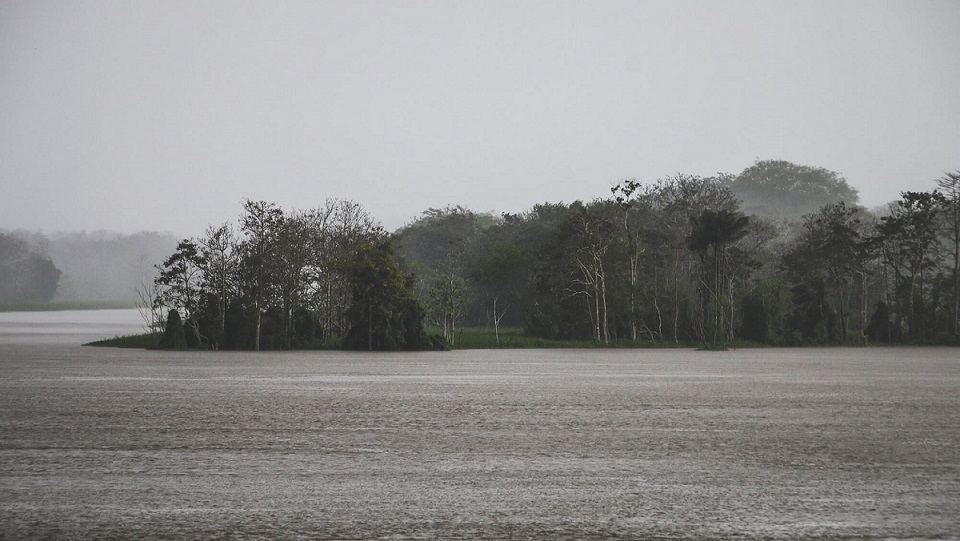
by Deep Green Resistance News Service | Apr 9, 2018 | Lobbying
Featured image: Dan From Indiana on flickr. Some Rights Reserved. The Rights of Nature Movement continues to advance through lawmaking and court decisions.
by The Community Environmental Legal Defense Fund (CELDF) via Intercontinental Cry
MERCERSBURG, PA, USA: Today, the Colombia Supreme Court of Justice issued a decision declaring that the Amazon region in Colombia possesses legal rights.
The Court declared that the “Colombian Amazon is recognized as an entity, a subject of rights” which include the right to “legal protection, preservation, maintenance and restoration.”
The Supreme Court’s decision builds on the precedent set in November 2016, when Colombia’s Constitutional Court ruled that the Atrato River possessed legal rights to “protection, conservation, maintenance, and restoration.” The Supreme Court refers to the 2016 decision in its ruling.
The Colombia Supreme Court ruling focused on the devastating impacts of deforestation and climate change on the Amazon, and the need to make significant change in how the region is protected.
In making its finding that the Amazon has rights, the Court cited the Constitutional Court’s 2016 opinion, in which that court wrote that it was “necessary to take a step forward in jurisprudence” to change the relationship of humankind with nature before “before it is too late or the damage is irreversible.”
The Community Environmental Legal Defense Fund (CELDF) – with its International Center for the Rights of Nature – has been at the forefront of the movement to secure legal rights of nature, partnering with communities, indigenous peoples, and governments in developing the world’s first Rights of Nature laws.
Transforming nature from being treated as property under the law, to be considered as rights-bearing – and thus in possession of legally enforceable rights – is the focus of the growing Rights of Nature movement.
Throughout history, women, indigenous peoples, and slaves have been treated as property under the law, without legal rights. Legal systems around the world today treat nature as property, and thus right-less. Under these systems, environmental laws regulate human use of nature, resulting in the decline of species and ecosystems worldwide, and the acceleration of climate change.
The first law was passed in Tamaqua Borough, Pennsylvania, in the United States, in 2006. Today, dozens of communities in more than 10 states in the U.S. have enacted Rights of Nature laws. CELDF assisted in drafting the first Rights of Nature constitutional provisions, which are part of the Ecuador Constitution of 2008.
Mari Margil, CELDF’s Associate Director who heads the organization’s International Center for the Rights of Nature explained, “The Court’s decision is an important step forward in moving to legal systems which protect the rights of nature.”
She added, “The collapse of ecosystems and species, as well as the acceleration of climate change, are clear indications that a fundamental change in the relationship between humankind and the natural world is necessary. We must secure the highest legal protections for nature through the recognition of rights.”
About the Community Environmental Legal Defense Fund (CELDF) & the International Center for the Rights of Nature
The Community Environmental Legal Defense Fund’s mission is to build sustainable communities by assisting people to assert their right to local self-government and the rights of nature. CELDF’s International Center for the Rights of Nature is partnering with communities and organizations in countries around the world to advance the rights of nature.
Today, CELDF is partnering with communities, indigenous peoples, and organizations across the United States, as well as in Nepal, India, Australia, and other countries to advance rights of nature legal frameworks.
by Deep Green Resistance News Service | Apr 4, 2018 | Lobbying
Spokane Judge Allows Necessity Defense; Washington State Appeals
Spokane – On March 8, Spokane District Court Judge Debra Hayes issued an order allowing for the necessity defense in a jury trial scheduled to start April 23, 2018, involving a climate change protestor’s alleged delay of oil and coal trains in September 2016. On March 30, the Spokane County Prosecuting Attorney’s Office appealed Judge Hayes’ ruling.
In September 2016, the Reverend George Taylor joined with fellow Veterans for Peace members to block coal and oil trains from passing through Spokane. Their action followed a similar action by the local Raging Grannies. All six protestors were charged with trespass and obstructing a train; five pled guilty for various reasons. Rev. Taylor chose to go forward to trial, and filed a motion asking the judge to allow him to present a “necessity defense,” i.e., that he committed one harm (trespass and blocking a train) to prevent greater harms (climate change and risks of oil train derailments).
After hearings on June 26 and August 21, 2017, Judge Hayes ruled that Taylor may present the necessity defense to the jury to justify his alleged civil disobedience. She noted, “Civil resistance is breaking a law to uphold a higher law when the threat is imminent and every legal means has not resulted in policy change.” (Order at p. 8).
“Climate change is real, and neither government nor industry is taking appropriate action to address it. Citizens therefore must bring their own voices and actions to bear to try to stop destruction of the planet,” said defendant Rev. George Taylor.
In this case, the necessity defense is based on two distinct environmental dangers to the Spokane area posed by transport of fossil fuels by train.
- First, the incineration of rail-transported coal and oil will contribute to climate change, which poses existential threats to the planet and all species, as soaring temperatures cause extreme weather patterns, disrupt ecosystems, and alter and destroy basic resources necessary for human life, including water availability and agricultural production.
- Second, rail transport of Bakken crude oil is extraordinarily dangerous as demonstrated by oil train derailments and explosions throughout North America, including at Mosier, Oregon on June 3, 2016.
Judge Hayes’ necessity order was supported by testimony of two experts: Dr. Steve Running, Professor of Global Ecology at the University of Montana and co-author of the 4th IPCC Report on Climate Change for which he shared the Nobel Peace Prize, and Prof. Tom Hastings, Assistant Professor of Conflict Resolution at Portland State University, and author of several books on civil resistance, including A New Era of Nonviolence (McFarland 2014).
Judge Hayes’ necessity order made numerous findings, including:
- The failure to act more forcefully to abate greenhouse gas (GHG) emissions will lead to harms that are severe, imminent, and irreparable, both at a global level and regionally in the Inland Northwest (Order at p.6);
- Civil resistance can be effective in bringing about social change; historic victories such as de-segregation and women’s suffrage have resulted from civil resistance and the same result could be accomplished for environmental protections, resulting in institutional, corporate and public policy changes (Order at p. 7); and
- When all other legal means have been taken, and those attempts have not resulted in change, the judicial branch is the last, best hope. (Order at p. 8).
“The judge nailed the problem: climate change is already causing adverse harms to the Inland Northwest ecosystems, which will in turn hurt people. And these harms will worsen. She found that it is reasonable to allow a jury to decide whether these harms outweigh George Taylor’s resistance actions for which he has been charged criminally,” said Rachael Paschal Osborn, Taylor’s attorney.
2016 saw the hottest global temperatures ever recorded; 2017, the second hottest year. The 400 parts per million of CO2 barrier has been exceeded – a key indicator of climate change – and the global average temperature continues to climb toward the two-degree Celsius threshold, a level that the international community has agreed should not be breached. This rise is expected to unleash even more erratic and devastating climate events such as the extreme wildfires experienced in the West and the devastating hurricanes that hit Texas, Florida, and Puerto Rico. In the U.S., we have long known that climate change is occurring but have failed to take action. Thirty years ago The New York Times reported that Climate Change Has Begun, Expert Tells Senate, but efforts to head off catastrophe have been continually delayed and thwarted by the fossil fuel industry.
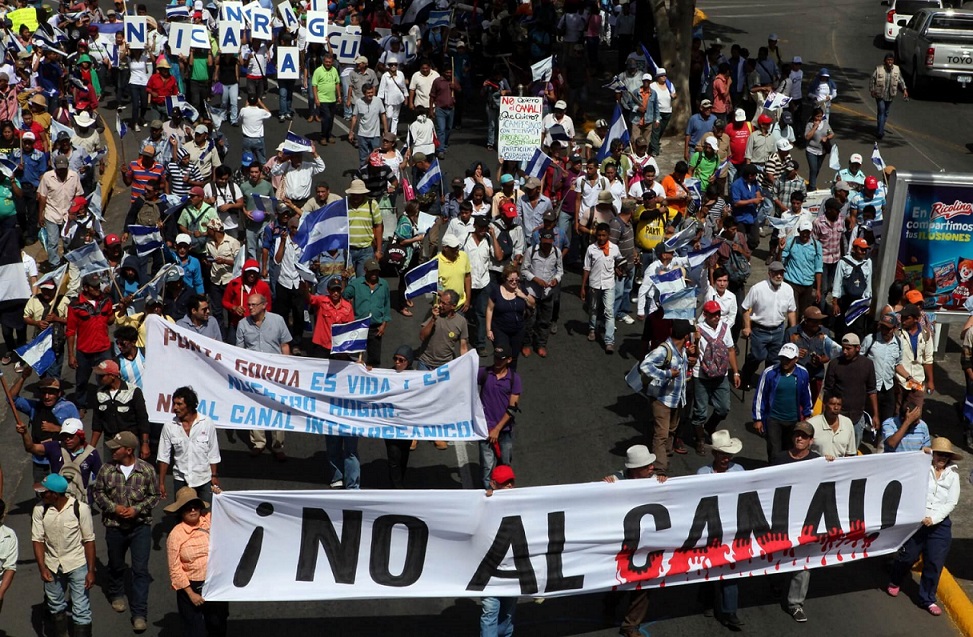
by Deep Green Resistance News Service | Mar 20, 2018 | Lobbying
Featured image: Mario Lopez/EPA
by Gabriella Rutherford / Intercontinental Cry
Indigenous communities know all too well of the potentially devastating risks that the construction of mega-projects can entail. Time and again, such projects have led to irreparable environmental damage that harmed if not destroyed the well-being, culture, economy and traditional ways of local communities.
The Raizal Peoples who inhabit the San Andrés, Providencia and Santa Catalina archipelago, Colombia could become one more indigenous community to be affected in this way. Should Nicaragua’s plans to build a canal go ahead, there is the risk that the massive project—that would rival the Panama Canal—would muddy and pollute nearby waters and potentially destroy the reef on which the Raizals depend.
With the risk of environmental damage and potentially devastating consequences for the Raizal Peoples in mind, Colombia applied to the Inter-American Court for information as to how it might interpret human rights law in this case. In response, the Court issued an advisory opinion in which it elaborated at length on the relationship between the environment and human rights law.
The Court noted, “Environmental damage can cause irreparable damage to human beings. As such, a healthy environment is a fundamental right for the existence of humanity.”
Its findings, though non-binding, sent out a strong message to both the regional and international arena that not only is there an inextricable link between a healthy environment and human rights but that this should be accounted for in the interpretation of human rights instruments.
In practice, this means that someone could in theory now bring a case before the Court on the grounds that environmental damage had led to a violation of their human rights. While significant legal obstacles have previously made it difficult for affected parties to seek meaningful redress in such cases, the verdict could not be more timely.
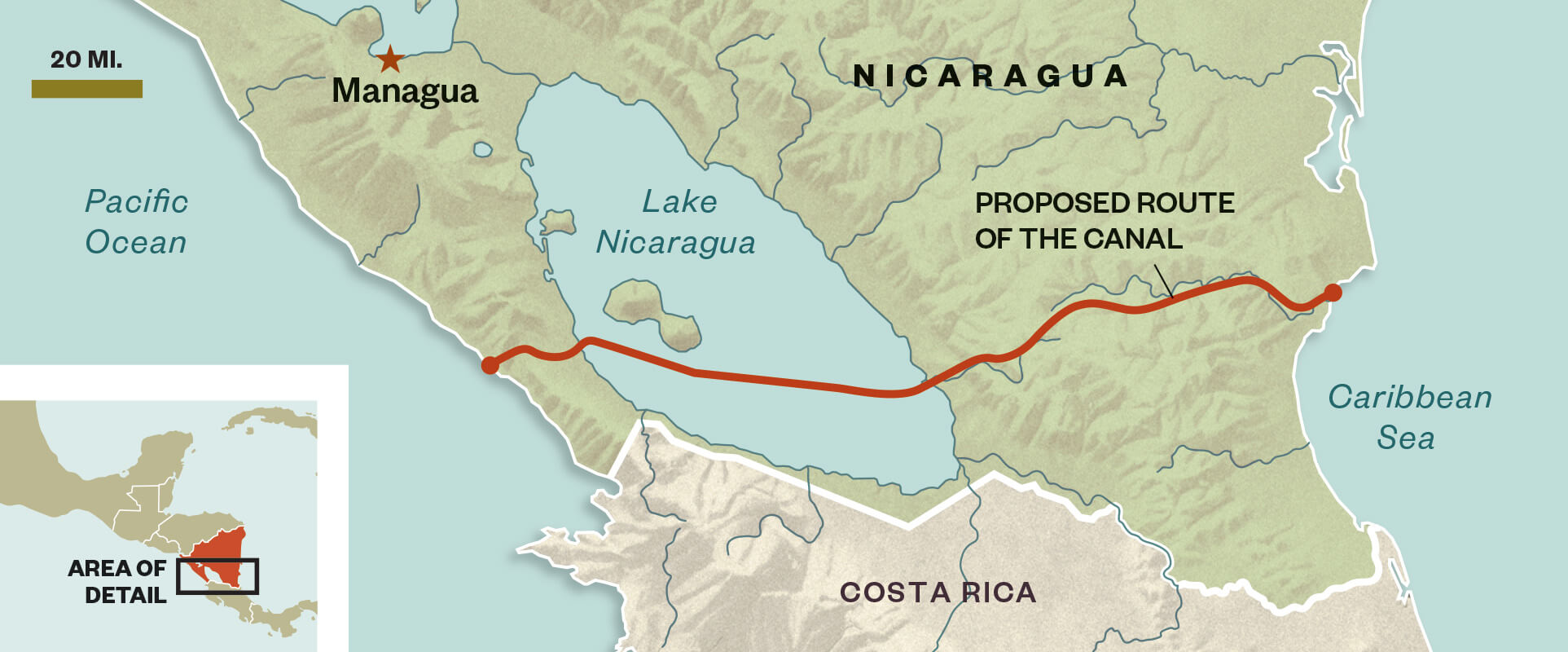
Proposed route of The Nicaraguan Canal (Spanish: Canal de Nicaragua), formally the Nicaraguan Canal and Development Project (also referred to as the Nicaragua Grand Canal, or the Grand Interoceanic Canal)
To date, claimants in the Americas affected by environmental damage have struggled to pursue legal action for the violation of their human rights for the following reasons:
Right to a healthy environment (San Salvador Protocol, article 11) not accepted as basis for a claim
Firstly, despite the fact that Article 11 of The San Salvador Protocol explicitly sets out the right to a healthy environment, this right is non-justiciable. That is to say, no-one could use a violation of this right as a basis for which to file a petition to the Inter-American Commission of Human Rights, and subsequently the Inter-American Court. Instead, the affected individual or group would have to bring a case under Article 26 of the American Convention on Human rights, the rights of which are justiciable.
The problem is that, while Article 26 protects economic, cultural and social rights, the only obligation it imposes on States is that they progressively achieve the full realization of these rights, making it an aspirational ideal for member States. For this reason, neither the Commission or the Court had previously ever found in favour of a claimant who had asserted their rights under this article. Furthermore, is has been unclear whether the right to a healthy environment would be deemed as being included in the scope of the rights protected under Article 26.
Problems of transboundary cases
In some cases, the cause of environmental damage occasioned in a particular place lies outside of a country’s border. This is problematic because human rights instruments are traditionally understood to only hold states responsible for damage occasioned in that same state, not for damage outside of their borders. This rather nebulous realm of extraterritorial obligations is, as one legal expert noted, “the conundrum…that bedevils human rights law”. If we can find some clarity in this rather nebulous world of international law it is that no-one hoping to a pursue legal action through the regional courts in the case of a transboundary claim could be confident their claim would be admitted.
Problems of bringing claims on the basis of violation of right to life
In theory, another means through which a potential affected party could file their complaint with the Inter-American Commission would be through arguing that their right to life had been violated as a result of environmental degradation. However, case law from the Inter-American Court shows that should a complainant want to argue their case on this basis, they would have to prove that the state had taken action which could be deemed to have an “immediate” and “certain” consequence on their exercise of their right to life–and that action wasn’t taken to “reasonably” prevent the risk of this happening.
There are cases which fall into this category such as Sarayaku vs. Ecuador, where explosives were laid on the Sarayaku territory or, for example, in Yanomami vs. Brasil where a highway was built though Yanomami land which resulted in several deaths. This said, clearly trying to prove the immediacy and certainty of a risk to life and integrity limits the number of cases significantly. By means of example, in 2005 when the Inuit argued that their traditional means of subsistence had been destroyed by climate change, the Inter-American Court did not find in their favour. Though the Court was not explicit with regards to its reasons for not accepting this argument, it can be supposed that it was indeed difficult to prove that climate change would have resulted in an “immediate” and “certain” negative impact on the subsistence of the Inuit Peoples and consequently their right to life.
The advisory opinion issued on Feb. 7 addresses these problems in the following way:
The right to a healthy environment
Firstly, the court reaffirmed the landmark decision made in the recent Lagos del Campo vs. Peru case, in which they found for the first time in favour of a claimant who had raised a petition on the basis of his Article 26 rights being violated. Secondly, the Court recognized that the right to a healthy environment as set out in the San Salvador Protocol was an autonomous right and crucially, should be deemed as being included in the rights set out in Article 26. What this means then is that the door is laid open to future claims for loss of a healthy environment brought under Article 26 of the American Convention, something that was not previously possible.
Transboundary claims will be actionable in the case of environmental damage
The Court found that countries will be held accountable for the violation of rights when the activities causing those violations are in their “effective control” i.e. they are responsible for them. This marks a significant widening of the traditional scope of a state’s responsibilities.
On this basis then, if, for example a state did complete a mega-project, the effects of which were felt outside of their borders, a case could be brought against them. In Colombia’s case, the Court seems to indeed be suggesting that should Nicaragua’s canal result in environmental damage in Colombia, affected parties would indeed have a case.
Some experts have noted that this could have important repercussions for air pollution, chemical pollution and even climate change.
Risk to life must still be “immediate” and “certain” but in the case of the possibility of significant environmental damage, a state has an obligation to prevent it taking place.
As expected, the Court’s opinion signaled no change with regards to the need for claimants to prove that actions undertaken would “immediately” and “certainly” result in the violation of their right to life. As such, it will remain difficult to bring forward claims on this basis. However, the Court did importantly recognize the very real potential that environmental damage has to cause violations of the right to life or right to integrity. With this in mind, it made several stipulations:
Firstly, the Court stated that States must prevent “significant environmental damage” (understood as damage that will violate right to life or integrity) both in or outside their borders. Secondly, it stipulated that they must do so even if there is no scientific certainty of such environmental damage: it is sufficient that significant environmental damage was possible.
The Court also offered clarity about what was understood by the meaning of the word ‘prevention’. It found that a State must conduct thorough and independent environmental impact studies as well as providing mitigation and contingency plans in the case of damage; regulate, supervise and monitor activities that could cause harm; cooperate with other States, providing them with information regards risks to the environment and ensure that potentially affected parties have access regarding potential harms
There is no doubt that the Inter-American Court’s findings offer reasons for optimism for both environmental and indigenous rights activists alike. Though non-binding, the advisory opinion provides a sign post for Courts of member States as well as lending much-needed legal weight to arguments made by potential claimants. Indeed, the advocacy group Dejusticia—which is currently pursuing legal action against the Colombian State for failing to curb deforestation in the Amazon—has said that it will use the findings to bolster its arguments. Of course, the advisory opinion will likely carry weight further afield too. The fact that a major human rights body such as the Inter-American Court has taken active steps to better protect citizens from the very real effects of environmental damage will surely put pressure on other major bodies to do the same.

by Deep Green Resistance News Service | Feb 13, 2018 | Protests & Symbolic Acts
by Buffalo Field Campaign
Mark your calendars and plan to join Buffalo Field Campaign for some winter rallies for wild buffalo!
Yellowstone, Montana, and other bison managers have aims to kill upwards of 900 of the gentle giants this winter, all to appease Montana’s infamous livestock industry. The country’s last wild buffalo — a sacred and keystone species who is our National Mammal — are in dire straights and we must rally together to demand that they are protected and allowed to flourish, not be slaughtered to satisfy the whims of the cattle industry.

BFC Week of Action!
February 12 – 18, 2018
Join us for a series of gatherings, events, and rallies that we have planned for various towns near Yellowstone National Park. Dates, locations, and details are as follows:
Feb. 12, Monday, BFC Headquarters, West Yellowstone, MT
Kick off the week at camp with a meet-and-greet, orientation, and feast before we begin the week’s events.
Feb. 13, Tuesday, Gardiner, MT. First Annual Rosalie Little Thunder Memorial Walk
At 1:30 pm, gather at the Gallatin National Forest Gardiner Ranger District Office, 805 Scott St W, Gardiner, MT. We will begin our walk at 2:00 pm. We will walk through the town of Gardinger, past the Roosevelt Arch, and down Old Yellowstone Trail through Yellowstone National Park, The walk will end around 5:30, at the Beattie Gulch Trailhead, where we will share a meal and then hold a candlelight vigil in solidarity with wild buffalo and all of their advocates.
Feb. 14, Wednesday, Bozeman, MT. Rally Through Downtown
We will have an information table at the Bozeman Library, 626 E Main St, Bozeman, MT, from 11:00 a.m. – 4:00 p.m. We will gather banners, signs, and puppets, and march up and down Main Street throughout the day. Lunch and snacks will be provided.
Feb. 15, Thursday, BFC Headquarters. National Call-in Day and Day in the Field
A day of rest, direct action trainings, and field orientations for folks at camp. Everyone around the country and the globe will chime in and make Yellowstone’s and Montana’s phones ring off the hook as we hold our National Call-in Day. Targets and contact information will be forthcoming.
Feb. 16, Friday, Helena, MT. Rally at the State Capitol
Meet on the steps of the state capitol building, 1301 East Sixth Avenue, from 12:00 p.m. – 3:00 p.m. for a rally. We will have speakers from various Tribes, BFC, and other organizations to share their inspiration about wild buffalo. We anticipate drumming, singing, and story-telling. Possibly a visit to Governor Bullock’s office. Folks are also welcome to visit the office of the Montana Department of Livestock to share your feelings with them. A hot meal will be provided after the event. More details regarding speakers, etc., will be shared as available.
Feb. 17, Saturday, West Yellowstone, MT. Rally Through West Yellowstone
Meet at BFC Headquarters by 8:00 am for breakfast, or by 11:30 to carpool to town, or meet at Buffalo Spirit at 12:00, 14 N Canyon St, West Yellowstone, MT. From noon until 3:00 p.m., we’ll break out the banners, signs, drums, and puppets and march through the town of West Yellowstone, which is the most visited entrance to Yellowstone National Park.
Feb. 18, Sunday, BFC Headquarters. Gathering, Feasting, Trainings, and Story-Sharing
Enjoy a day in the field with the buffalo, learn from experienced activists, relish a delicious dinner, then share the stories and songs from your culture or your experiences, and learn from others. This close-down to our Week of Action is a bonding time that strengthens our solidarity as we move forward to defend the Earth from wherever we roam.
More information will be provided as we build these events. Please RSVP with our volunteer coordinators at volunteer@buffalofieldcampaign.org or call 406-646-0070. Bring friends, bring creative energy, bring your love for the wild!







